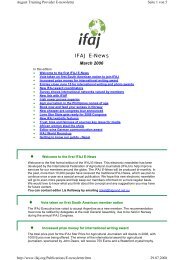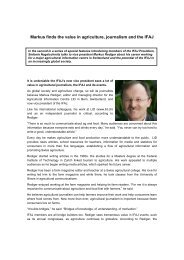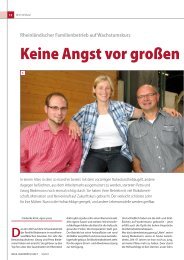Sweden! - International Federation of Agricultural Journalists
Sweden! - International Federation of Agricultural Journalists
Sweden! - International Federation of Agricultural Journalists
Create successful ePaper yourself
Turn your PDF publications into a flip-book with our unique Google optimized e-Paper software.
26 SOLUTIONS FOR A GREEN FUTURE<br />
Sheep and lambs<br />
Sheep and lamb breeding in <strong>Sweden</strong> is, to a large extent,<br />
small scale. Every third farm has a maximum <strong>of</strong> 9 fullygrown<br />
animals.<br />
A positive trend<br />
In contrast to pigs and cattle, sheep and<br />
lamb breeding has experienced a positive<br />
development in the last few years.<br />
Production has increased, as has Swedes’<br />
consumption <strong>of</strong> lamb. Consumption is,<br />
however, still on a low level compared to<br />
many other countries. The average Swede<br />
eats between 1–2 kilograms <strong>of</strong> lamb every<br />
year.<br />
More and more animals<br />
The number <strong>of</strong> ewes and rams in <strong>Sweden</strong><br />
was 254,000 in 2009 and the number <strong>of</strong><br />
lambs was 287,000. In total, the number<br />
<strong>of</strong> sheep has increased by 149,000 animals<br />
since 1980. This corresponds to an increase<br />
<strong>of</strong> 38 percent.<br />
The production <strong>of</strong> Swedish lamb has<br />
grown by more than 50% since 1995.<br />
Problems<br />
Sheep and lamb breeding is still, to a great<br />
extent, partly a hobby for many farmers.<br />
Small scale farming continues to be a problem<br />
which leads to a production that does<br />
not adjust to the demand. The abattoirs<br />
and meat companies want lambs in the period<br />
before New Year, Easter and Ramadan<br />
– these are the three high points during the<br />
year when demand is greatest. However,<br />
most lambs are delivered to the abattoirs in<br />
the autumn because it is cheaper to raise a<br />
lamb which is born in the spring and then<br />
goes out to graze all summer. The abattoirs<br />
raise the basic listing price steeply in the<br />
weeks preceding the three high points to<br />
make farmers more business minded and<br />
make them deliver lambs when demand is<br />
highest.<br />
Where sheep and lambs are<br />
The three counties which have the most<br />
sheep and lambs are Västra Götaland,<br />
Skåne and Gotland.<br />
Prices<br />
The prices for lamb vary throughout<br />
the year. The highest prices are before<br />
Ramadan, New Year and Easter. During<br />
2010, the basic listing price was swinging<br />
back and forth between 24 and 32 SEK<br />
per kilogram for a lamb weighing 16–23<br />
kilograms. Supplements add extra SEK per










